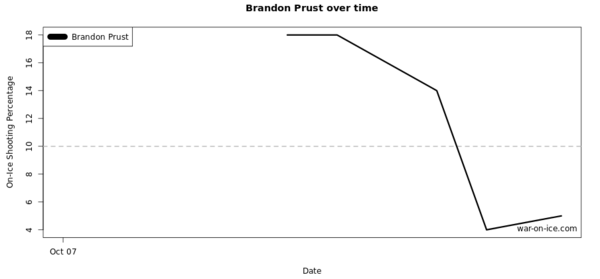Though controversial, the Vancouver Canucks acquisition of Brandon Prust was done with the best of intentions.
Prust was expected to bring with him a set of fists and grinder know-how to the Canucks bottom-six while all the while rubbing shoulders with the team’s future. In essence, the Canucks were doubling down on Derek Dorsett. And were luck on their side, they might have landed a comparable piece.
Every sign pointed to Prust being the high-end bottom-six player he came as advertised. Better even, as Prust displayed high-end playmaking en route to five assists in his first nine games. The pugilist would suffer an ankle injury to bookend that streak, October 27th, ending the short burst of playmaking prowess and any real chance of getting anything of value out of their July 1st investment.
The player that returned to the Canucks lineup a month later was a shadow of his former self. The once effective forechecker was always a step or three behind the play. In the 26 games that followed the ankle injury, Prust chipped in just two points – both scored in the same game. His fights – if you could even call them that – were more similar to hugs than boxing. And when he couldn’t even do that well, the Canucks pulled the plug on the Prust experiment and sent him to their farm club in Utica. Never to be seen again.
HERO Chart

Crunching Numbers:
Boxcars:

Over 70% of Prust’s seven points came in the month of October, over a span of nine games. Not surprisingly, a spike in on-ice shooting percentage played a large part in bolstering these numbers. That’s not to take away from Prust’s accomplishments entirely. Daniel Wagner at Pass it to Bulis did an excellent job going into detail about Prust’s setup abilities and uncovered some pretty nifty playmaking.

Corsi:

Though Prust was far from a positive possession player with the Canucks, he wasn’t an anchor by any means either. That’s a low bar to clear, but this is a fourth line player we’re talking about.
Goal-based:

Underlying goal data is often subject to swings in both directions over a short enough sample and Prust’s 35 games qualify. With an on-ice Sh% of 5%, that carries weight for this particular player.
Scoring Chances:

One would like to point to Prust’s 0.2 SCF%Rel as a non-negative, but it doesn’t mask the stench of an SCF% of 42.1%. The Canucks may have been marginally better at controlling scoring chances with Prust than without, but they were still terrible.
Conclusion
So much of Prust’s game is dependent on his ability to skate and get in on the forecheck. If his last months as a Canuck are any indication, he’s no longer capable of doing that at an NHL level. And while it’s less a matter of ability than willingness, Prust appears none too keen to carry on in his established role as an enforcer. Certainly not with any gusto.
There might be room in the NHL for a player like Brandon Prust. I’m just not necessarily sure where. The role of the enforcer is being phased out, and as his body deteriorates further into his thirties, it’s fair to wonder if he has much else to give outside that role.

